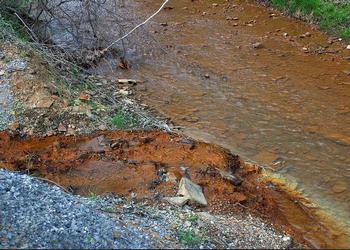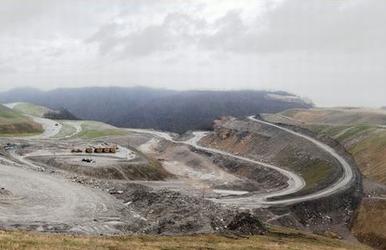New U.S. Stream Protection Rule Infuriates Big Coal
WASHINGTON, DC, July 16, 2015 (ENS) – New national regulations to prevent or minimize the impacts of coal mining on surface water, groundwater, fish and wildlife were proposed today by the Obama Administration. The Stream Protection Rule would safeguard about 6,500 miles of streams nationwide over a 20 year period.
The proposed Stream Protection Rule would affect the ability of mountaintop removal coal mining companies to destroy or bury waterways near surface mining operations. Mountaintop removal mining has already buried more than 2,000 miles of streams in Appalachia, while thousands more miles have been poisoned by toxic mine waste.

Stream pollution from coal mines near Route 160 in Letcher County, Kentucky (Photo by ILoveMountains)
The National Mining Association, an industry group, was scathing in its criticism of the proposal, calling it “the latest in a series of costly and unnecessary regulations from an administration that appears determined to destroy coal mining communities.”
But environmental groups warn the proposed rule is too weak and demand that the existing highly-protective buffer zone requirement, which clearly prohibits harmful activities within 100 feet of streams, be fully implemented.
Introducing the proposed rule, which would replace 1983 regulations, Interior Secretary Sally Jewell said today the federal government will work with coalfield communities to support their jobs while at the same time protecting the waterways near coal mines.
“We are committed to working with coalfield communities as we support economic activity while minimizing the impact coal production has on the environment that our children and grandchildren will inherit,” she said.
“This proposed rule would accomplish what Americans expect from their government,” said Jewell, “a modern and balanced approach to energy development that safeguards our environment, protects water quality, supports the energy needs of the nation, and makes coalfield communities more resilient for a diversified economic future.”
The proposed rule is meant to keep pace with current science, technology, and modern mining practices, she said.
It would require companies to avoid mining practices that permanently pollute streams, destroy drinking water sources, increase flood risk, and threaten forests.
The rule would require coal companies to test and monitor the condition of streams that their mining might impact before, during and after their operations.
It would also require companies to restore streams and return mined-over areas to the uses they were capable of supporting prior to mining activities, and replanting them with native trees and vegetation unless a conflicting land use is implemented.
“The proposed rule is projected to have a minimal impact on the coal industry overall,” the Interior Department officials said in a statement.
“In developing the proposed rule, we conducted extensive public outreach and were informed by the interests of coal country residents and others, including those directly and indirectly employed by the industry and those living with the impacts of mining on a daily basis,” said Joseph Pizarchik, director of Interior’s Office of Surface Mining Reclamation and Enforcement (OSM).
“That is why we are having a robust public comment process,” Pizarchik said, “to provide all stakeholders the opportunity to provide input on the proposed changes.”

The mountaintop removal site at Kayford Mountain, West Virginia. (Photo by Kate Wellington)
The mining group is urging Congress to block the rule. “This is a rule in search of a problem,” said NMA President and CEO Hal Quinn. “The agency’s own reports on existing state regulatory programs show the vast majority of mine sites are free of any offsite impacts, and the agency has produced no evidence to justify more regulations, let alone redundant ones that interfere with state agencies mining and water quality laws.”
Quinn objects that the proposed rule was developed without the input of state agency experts. “By ignoring state officials, OSM has made a mockery of the administration’s pledge toward greater transparency. What OSM has made transparent is the need for Congress to bridle an agency and a rule that is more about extending its bureaucratic reach than improving environmental performance.”
For their part, the environmental groups complain that the rule doesn’t go far enough. They warn the proposal weakens the Stream Buffer Zone rule, which prohibits harmful mining activities within 100 feet of Appalachian streams.
“Appalachian communities rely on the rivers and streams covered by these protections, and today’s proposal doesn’t adequately safeguard those communities,” said Sierra Club Beyond Coal Senior Director Bruce Nilles.
Thom Kay, legislative associate with the nonprofit group Appalachian Voices, said, “The people of Central Appalachia have waited a long time for robust federal action to protect their streams and communities from the damages of surface coal mining.”
Kay says the proposal still allows toxic mining waste to enter streams. “At first glance, the draft appears to improve some drastically outdated provisions of an ineffective rule. But it’s not worth cheering for the rule as long as it allows companies to continue dumping their mining waste in our streams,” he said.
Attorney Jane Davenport at Defenders of Wildlife said, “It is the responsibility of the Office of Surface Mining and state authorities to protect drinking water and wildlife habitat from the catastrophic effects of mountaintop removal mining. This proposal, though it does encourage increased safety monitoring and stream restoration, just doesn’t do the job.”
Copyright Environment News Service (ENS) 2015. All rights reserved.
http://ens-newswire.com/2015/07/16/new-u-s-stream-protection-rule-infuriates-big-coal/